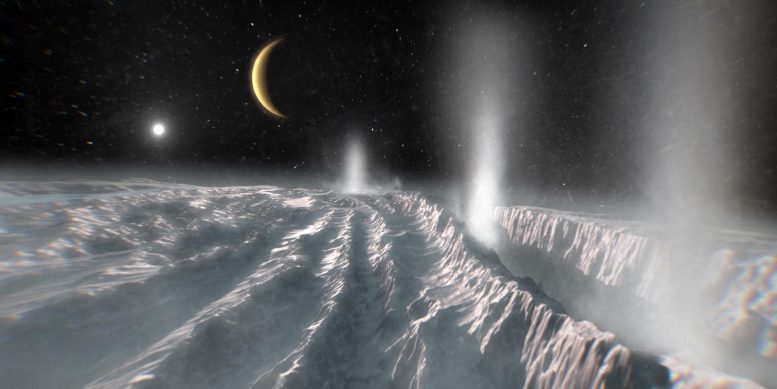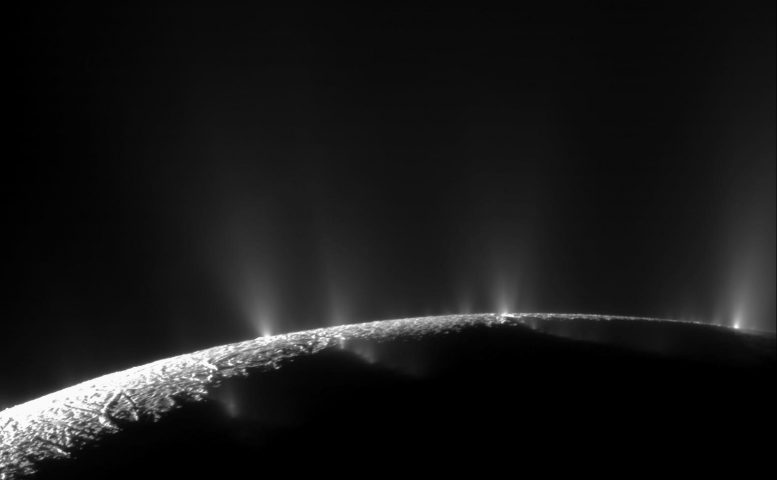
Saturn’s moon Enceladus has long dazzled scientists with its icy plumes that spew water and mysterious organic molecules into space, fueling hopes of a habitable ocean beneath. But new experiments suggest the story may be more complicated.
Researchers found that radiation bombarding Enceladus’s frozen surface could be producing many of the same organics detected in the plumes — meaning they might not come from the hidden ocean at all. This twist forces scientists to rethink how we interpret signs of habitability on icy moons.
Radiation or Ocean Origins?
Organic molecules observed in the watery jets erupting from Enceladus may not come from its underground ocean after all. Instead, researchers suggest that radiation striking the icy surface of Saturn’s moon could be responsible for creating them. The results, unveiled this week at the EPSC–DPS2025 Joint Meeting in Helsinki, add a new layer of complexity to how scientists evaluate the potential habitability of Enceladus’s hidden sea.
“While the identification of complex organic molecules in Enceladus’s environment remains an important clue in assessing the moon’s habitability, the results demonstrate that radiation-driven chemistry on the surface and in the plumes could also create these molecules,” said Dr. Grace Richards, of the Istituto Nazionale di Astrofisica e Planetologia Spaziale (INAF) in Rome, who presented the findings at the conference.

Cassini’s Stunning Discovery of Enceladus Plumes
In 2005, NASA’s Cassini mission first spotted the dramatic plumes spraying into space from Enceladus’s south pole. These geyser-like jets rise from deep fractures known as “tiger stripes.” The moon’s underground ocean supplies the water, while Saturn’s immense gravity stretches and flexes Enceladus’s interior, generating the heat needed to drive the eruptions.
Cassini later flew directly through these plumes, analyzing their chemical makeup. The spacecraft detected high levels of salts along with an assortment of organic molecules. Because such compounds, when dissolved in water, could assemble into prebiotic chemicals that precede life, the discovery immediately drew the attention of astrobiologists searching for environments beyond Earth that might sustain biology.

Radiation Chemistry on an Icy Moon
However, results of experiments by Richards and her colleagues show that the exposure to radiation trapped in Saturn’s powerful magnetosphere could trigger the formation of these organic compounds on Enceladus’s icy surface instead. This calls into question their astrobiological relevance.
Richards, with funding from Europlanet, visited facilities at the HUN-REN Institute for Nuclear Research in Hungary, where she and colleagues simulated the composition of ice on the surface and in the walls of Enceladus’s tiger stripes. This ice contained water, carbon dioxide, methane, and ammonia, and was cooled to -200 degrees Celsius. Richards’ team then bombarded the ice with ions – atoms and molecules stripped of an electron – to replicate the radiation environment around Enceladus. The ions reacted with the icy components, creating a whole swathe of molecular species, including carbon monoxide, cyanate, and ammonium. They also produced molecular precursors to amino acids, chains of which form proteins that drive metabolic reactions, repair cells, and convey nutrients in lifeforms.
Prebiotic Molecules Without an Ocean?
Some of these compounds have previously been detected on the surface of Enceladus, but others have also been identified in the plumes.
“Molecules considered prebiotic could plausibly form in situ through radiation processing, rather than necessarily originating from the subsurface ocean,” said Richards. “Although this doesn’t rule out the possibility that Enceladus’s ocean may be habitable, it does mean we need to be cautious in making that assumption just because of the composition of the plumes.”
The Challenge Ahead for Future Missions
Understanding how to differentiate between ocean-derived organics and molecules formed by radiation interacting with the surface and the tiger stripes will be highly challenging. More data from future missions will be required, such as a proposed Enceladus mission that is currently under consideration as part of the Voyage 2050 recommendations for the European Space Agency (ESA)’s science program up until the middle of the century.
Reference: “Water-Group Ion Irradiation Studies of Enceladus Surface Analogues” by Grace Richards, Richárd Rácz, Sándor Kovács, Victoria Pearson, Geraint Morgan, Manish Patel, Simon Sheridan, Duncan Mifsud, Béla Sulik, Sándor Biri and Zoltán Juhász, 8 July 2025, EPSC-DPS Joint Meeting 2025.
DOI: 10.5194/epsc-dps2025-264
Never miss a breakthrough: Join the SciTechDaily newsletter.